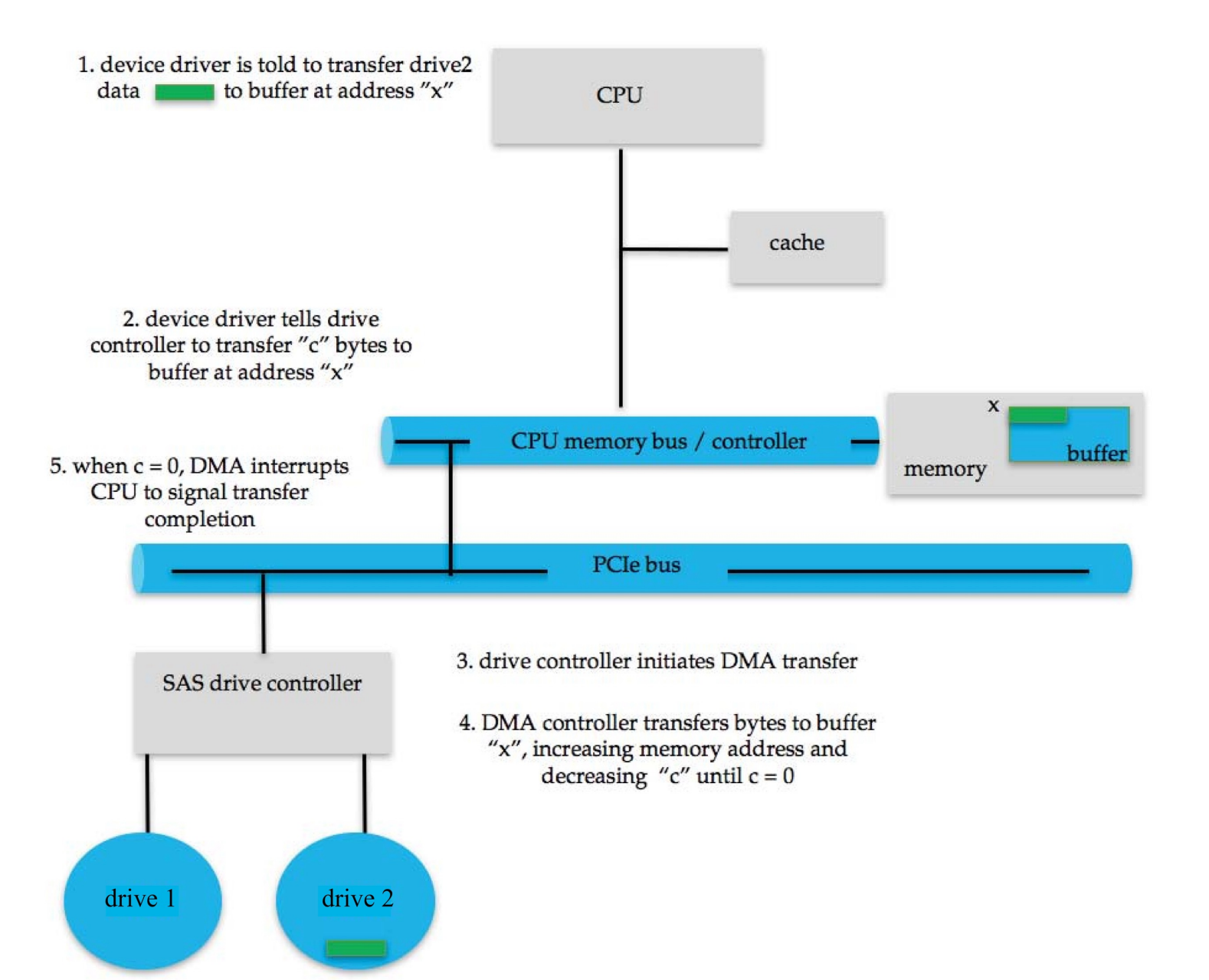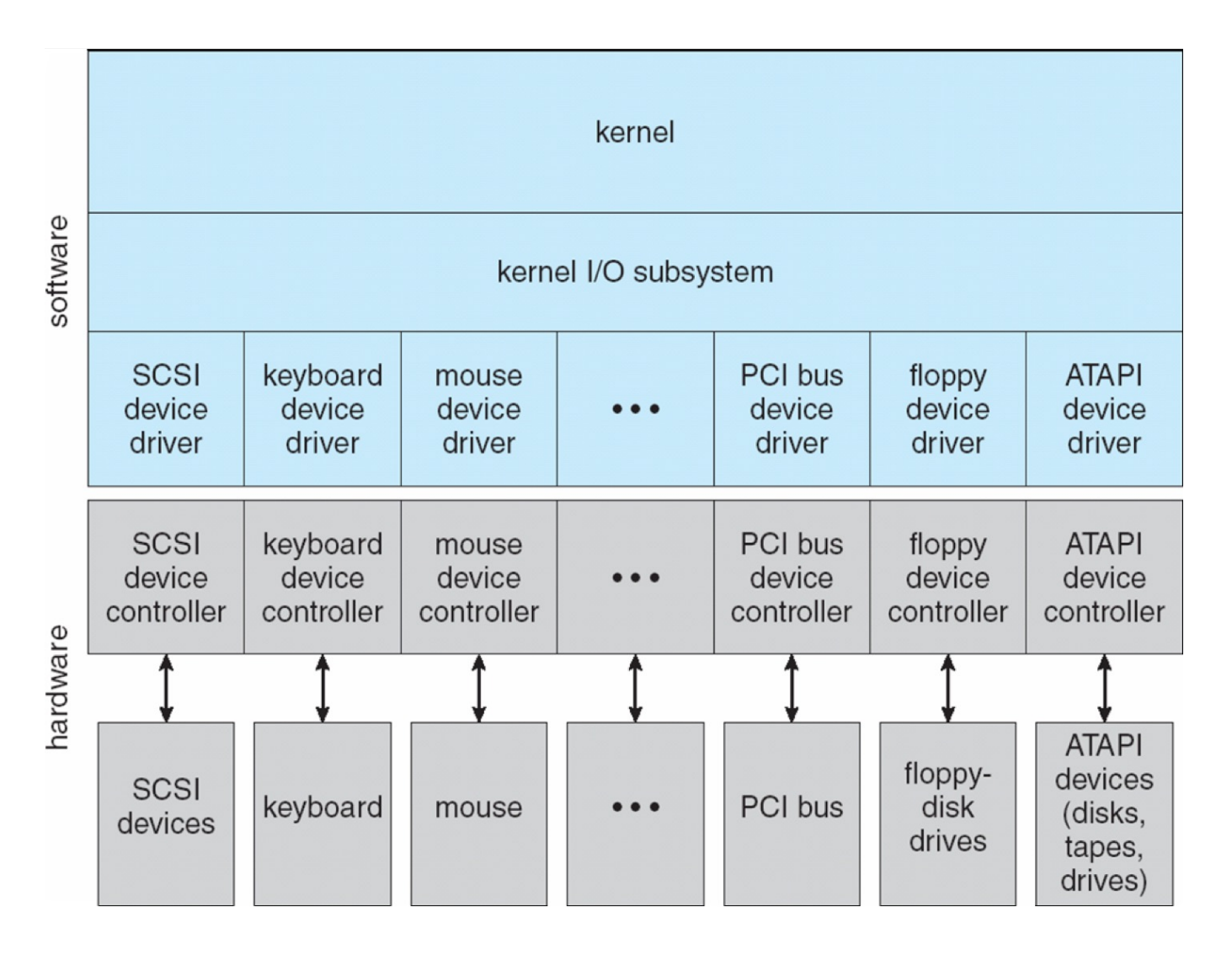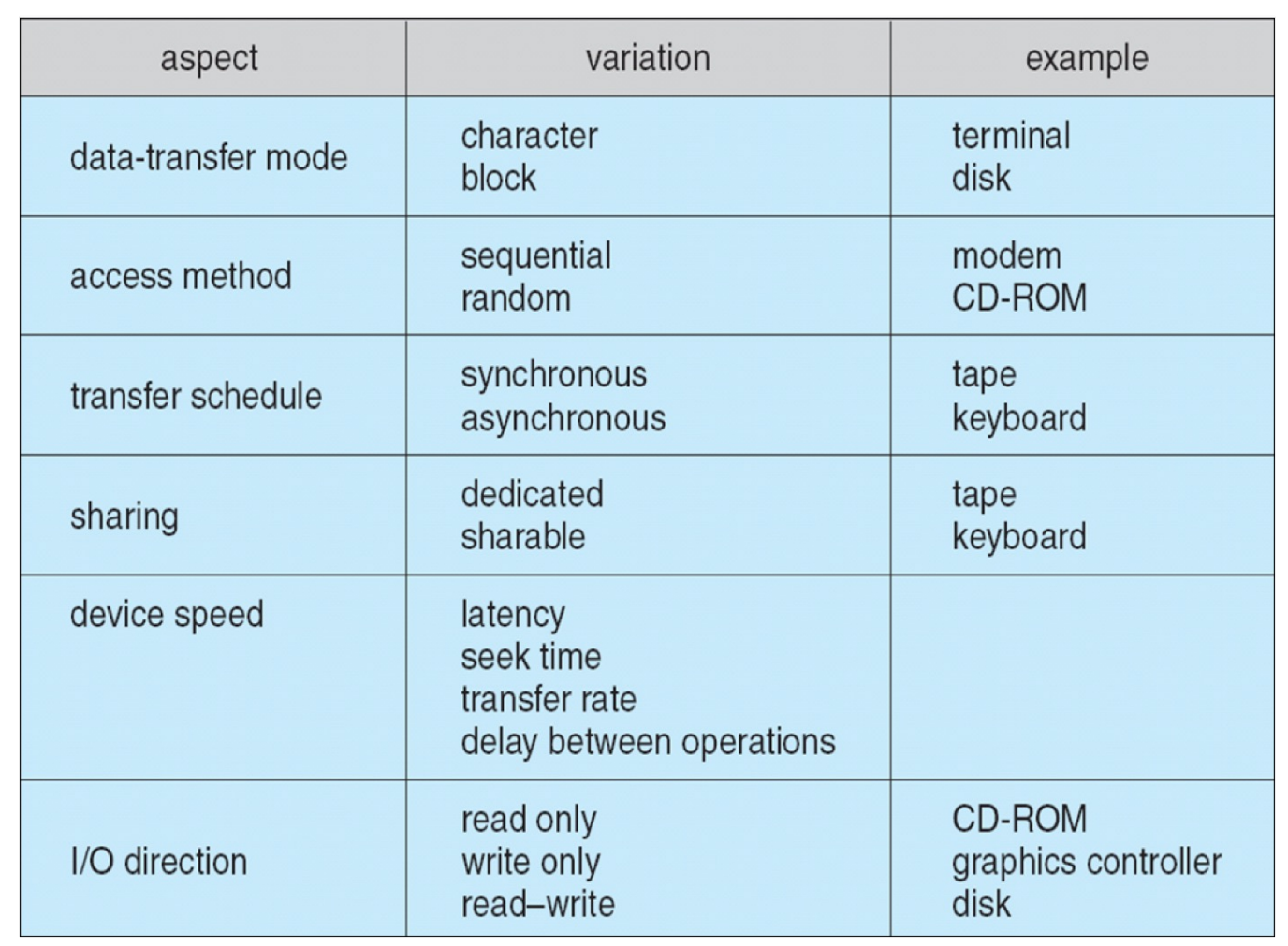I/O Systems¶
Overview¶
I/O management is a major component of OS design and operation.
-
important aspect of computer operation
-
I/O devices vary greatly
IO 设备差异很大,如网卡、鼠标键盘、显示器。
- new types of devices frequently emerge
手机的CPU和内存装到电脑上还能用
下图里除了处理器和内存,均是外设。

I/O Hardware¶
Common concepts: signals from I/O devices interface with computer
- bus 用来做设备和 CPU 的互连。
- port: connection point for device
- controller: usually contains processor, microcode, private memory, bus controller, etc
I/O access can use polling or interrupt.
- polling: IO主动向CPU发请求,CPU中断
操作系统空闲的时候在等event(interrupt和exception也算event)
timer interrupt:减少时间片,减到0 schedule
- Some CPU architecture has dedicated I/O instructions.
如 x86 里有 in, out。
-
Devices usually provide registers for data and control I/O of device
-
Registers include data-in/data-out, status, control or command register
-
Devices are assigned addresses for registers or on-device memory
-
direct I/O instructions
扩展性差,现在使用的少。
-
memory-mapped I/O
把外设映射到内存地址空间,这样就可以用内存访问指令来访问外设。
Polling¶
CPU 主动询问设备,是否需要服务。
For each I/O operation:
- busy-wait if device is busy (status register)
- Cannot accept any command if busy
- send the command to the device controller (command register)
- read status register until it indicates command has been executed
- read execution status, and possibly reset device status
Polling requires busy wait. busywait 需要锁,会 sleep。所以如果设备很快那么轮询是合理的;如果设备很慢那么会很低效。
spinlock也有busy waiting
解决busy waiting: yield -> moving from running to sleeping
解决busy waiting
Interrupts¶
Interrupts can avoid busy-wait
cpu中call device的线程(t1 for example)进入device的waiting queue,然后cpu切换到其他线程,等device执行完后给cpu发一个interrupt,同时把t1加入cpu的ready queue
- device driver (part of OS) send a command to the controller (on device), and return
- OS can schedule other activities
- device will interrupt the processor when command has been executed
- OS retrieves the result by handling the interrupt
Interrupt-based I/O requires context switch at start and end. 如果中断发生的频率很高,那么上下文切换会浪费很多 CPU 时间。
- 下图虚线中CPU在执行其他线程

- Interrupt is also used for exceptions
- protection error for access violation
- page fault for memory access error
- software interrupt for system calls
- Multi-CPU systems can process interrupts concurrently
- sometimes a CPU may be dedicated to handle interrupts
- interrupts can also have CPU affinity
SMP IRQ Affinity¶
- It allows you to restrict or repartition the work load that you server must do so that it can more efficiently do it's job.
- "balance" out multiple NiCs in a multi-processor machine. By tying a single NIC to a single CPU, you should be able to scale the amount of traffic your server can handle nicely.
Direct Memory Access¶
DMA transfer data directly between I/O device and memory.
GPU/NPU/TPU等XPU 访问内存也算 DMA,只要不经过 CPU 就算。
- device driver在CPU上跑,所有的controller都是在设备上跑的
- 第2步使用syscall ioctl

Application I/O Interface¶
I/O system calls encapsulate(封装) device behaviors in generic classes.
- in Linux, devices can be accessed as files; low-level access with
ioctl.
抽象成file,因为read和write的第一个参数是fd,这样所有内容都可以用read和write读了
Device-driver layer hides differences among I/O controllers from kernel.

Devices vary in many dimensions

设备可以被大致分为:
- Block and Character Devices
以块为单位访问数据。支持 read, write, seek 操作。可以通过内存映射访问,也有 DMA。
其中 character I/O 指逐个字节传输(Stream)。
-
Network Devices: socket
-
Clocks and Timers: provide current time, elapsed time, timer.
-
memory-mapped file access
Synchronous/Asynchronous I/O
-
Synchronous I/O includes blocking and non-blocking I/o
-
blocking I/O: process suspended until I/O completed
-
non-blocking I/O: I/O calls return as much data as available
-
Asynchronous I/O: process runs while I/O executes,
-
I/O subsystem signals process when I/O completed via signal or callback
Kernel I/O Subsystem¶
-
I/O scheduling
-
Buffering - store data in memory while transferring between devices.
-
Caching: hold a copy of data for fast access.
-
Spooling: A spool is a buffer that holds the output (device’s input) if device can serve only one request at a time.
-
Device reservation: provides exclusive access to a device.
-
OS needs to protect I/O devices.
-
keystrokes can be stolen by a keylogger if keyboard is not protected
通过键盘输入获取密码
-
to protect I/O devices
-
define all I/O instructions to be privileged
- I/O must be performed via system calls
-
memory-mapped I/O and I/O ports must be protected too
-
kernel data structures
- Kernel keeps state info for I/O components
- e.g., open file tables, network connections, character device state
- Some OS uses message passing to implement I/O, e.g., Windows
- message with I/O information passed from user mode into kernel
- message modified as it flows through to device driver and back to process

I/O Requests to Hardware¶
- System resource access needs to be mapped to hardware

Performance¶
I/O is a major factor in system performance
比如磁盘很慢,开机很耗时间
Improve Performance¶
- Reduce number of context switches
- Reduce data copying
- Reduce interrupts by using large transfers, smart controllers, polling
- Use DMA
- Use smarter hardware devices
- Balance CPU, memory, bus, and I/O performance for highest throughput
- Move user-mode processes / daemons to kernel threads
Linux IO¶
- Device initialization 需要先注册,注册的时候会把设备对应正确的读写操作的函数也给初始化
- /dev/tty
- tty_init
- create /dev/tty file

- Device write: Write (echo) to the file reach vfs_write, which eventually calls tty_write